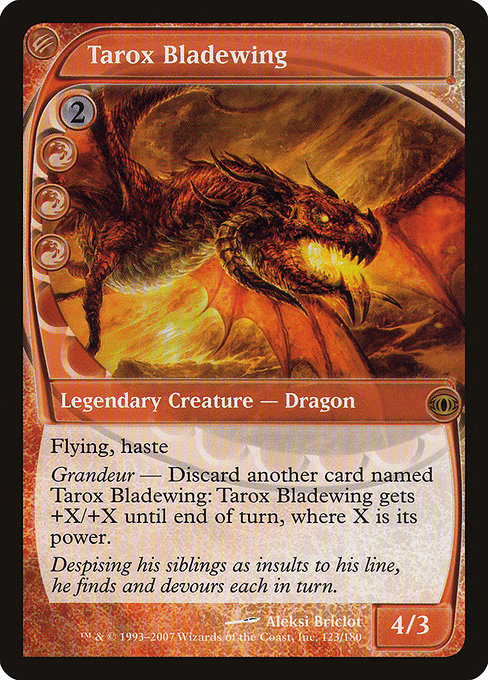
Image courtesy of Scryfall.com
Tarox Bladewing in Deck-Outcome Modeling: A Red-Flash of Insight
If you’re chasing clean, repeatable value in red-heavy builds, Tarox Bladewing is a fascinating lens for how a single card can tilt probability, tempo, and late-game inevitability. This legendary dragon from Future Sight isn’t just a 4/3 flier for five mana with haste; it carries a momentum-kicker in its Granduer ability: discard another Tarox Bladewing to give Tarox +X/+X until end of turn, where X is its own power. In practical terms, that means the card’s true value isn’t just its body on the battlefield, but the dynamic swing it can generate when you pair it with copy effects, pumping enablers, and the occasional recursive draw engine. 🧙♂️🔥
To model deck outcomes, you start with the core stats: mana cost 5, red color identity, rarity rare, and the stats 4 power / 3 toughness with flying and haste. Those ensure early-clock pressure and the potential for explosive finishes when you can stack power reasonably fast. The Grandeur clause invites a deliberate hand-building approach: you need two Tarox Bladewings in your hand to enable the buff reliably, which introduces a trade-off between raw aggression and hand discipline. In a typical 60-card red deck, the probability of drawing the second Tarox by turn 4–5 hinges on draw speed, mulligan rules, and any redundancy in the deck. When the granduer trigger lands, the buff can redefine combat math in a single swing, turning a 4/3 attacker into a towering threat that forces your opponent to answer immediately. ⚔️
From a modeling standpoint, Tarox’s value is a function of several layers: base stall and pressure, the probability of triggering Grandeur, and the post-buff threat level after accounting for blockers, burn, and removal. Let’s break that down with a practical thought exercise. Imagine you’ve opened a hand with Tarox and a second Tarox, plus a couple of mana accelerants (think Red-based ramp or cantrips). On turn 3 or 4 you drop Tarox, discard the other Tarox to propel its power, and push a big swing that can weather a removal spell or force a race. If you don’t draw the second Tarox, the Grandeur engine sits idle—your EV shifts toward traditional red tempo and card draw to refill the hand. This is where modeling shines: you quantify the likelihood of hitting the buffer versus committing to a plan-ahead burn plan. The result is a spectrum, not a single number, and it captures why Tarox shines in certain shells more than others. 🧠🎲
Flavor and design meet math in Tarox Bladewing. The flavor text—“Despising his siblings as insults to his line, he finds and devours each in turn”—feels like a microcosm of deck outcomes: you leverage a single, audacious play to erase the pressure of an entire lineup of threats. It’s a reminder that in MTG, value often hides in the margins: moments when a card’s long-term power aligns with a precise, short-term setup. The card’s art by Aleksi Briclot reinforces that sense of scale and danger, a dragon that demands attention the moment it takes wing. 🎨
When we talk about real-world practice, Tarox’s place in decklists often slides into red midrange or dragon-centric builds where the focus is not just raw damage but probability management. In board states where you’ve already established pressure—think a swift curve of early threats and a few efficient removal spells—Tarox can act as a high-variance capstone. The pump from Grandeur scales with Tarox’s own power, so any incidental boosts—doubling effects, anthem-like effects, or even temporary power buffs—multiply the impact of the buff. It becomes a question of “how big can the swing be, given how much power we’ve mustered?” and “how often do we see two Taroxes in hand to bankrupt the opposition’s defenses?” 🧙♂️💥
Key stats and design notes at a glance
- mana_cost: {2}{R}{R}{R}
- color: Red
- type: Legendary Creature — Dragon
- power/toughness: 4/3
- abilities: Flying, Haste; Grandeur — Discard another card named Tarox Bladewing: Tarox Bladewing gets +X/+X until end of turn, where X is its power.
- rarity: Rare
- set: Future Sight (FUT)
- flavor text: “Despising his siblings as insults to his line, he finds and devours each in turn.”
Financially, Tarox Bladewing sits in an interesting niche. Its foil print carries a premium, and the non-foil is affordable, with the card price showing modest volatility typical of older, non-rotating formats. The EDHREC rank sits in the higher digits, reflecting interest in dragon-heavy or multi-Tarox combos, even if it’s not a staple. For collectors and players alike, Tarox’s aura isn’t just about a momentary win condition—it’s about the story of a card whose versatility improves when you embrace the math of probability and the poetry of a well-timed Grandeur trigger. 💎
As you think about building around Tarox, remember to weave in consistency tools: draw engines, tutors, and ways to fetch a second Tarox when necessary. The deck’s resilience hinges on your ability to navigate the variance of drawing two Taroxes, while also keeping a steady stream of pressure from your other threats. And if you want a small, practical tie-in with real-world merch, you can celebrate your MTG space with a clean desk setup: a sturdy mouse pad, like the Eco-Friendly Vegan Leather Mouse Pad, which pairs nicely with the high-stakes tempo of a red deck—no-slip backing and eco-conscious materials for long practice sessions. 🧙♂️🔥🎯
Eco-Friendly Vegan Leather Mouse PadMore from our network
- https://blog.digital-vault.xyz/blog/post/haro-backlinks-a-practical-step-by-step-guide/
- https://blog.digital-vault.xyz/blog/post/tracing-ichor-aberrations-reprint-pricing-lifecycle/
- https://crypto-acolytes.xyz/blog/post/minecraft-warden-survival-tips-master-the-deep-dark/
- https://blog.digital-vault.xyz/blog/post/implementing-freemium-pricing-a-step-by-step-guide/
- https://crypto-acolytes.xyz/blog/post/solanas-road-to-institutional-adoption-strategies-and-milestones/